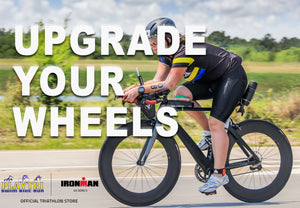
UNLOCK THE OPEN WATER SWIM: 5 KEYS TO SUCCESS

Don't just survive your next open water swim. Here's how to nail your swim when it takes you outside the (chlorinated) box.
Transitioning from the pool to the open water is one of the toughest—and most important—lessons a triathlete must learn. Swimming back and forth in the pool, alone or with your fellow Masters swimmers, simply isn’t the same as toeing the line in a full field of competitors. Whether the race features a mass or wave start, the outdoor environment brings unexpected anxiety and requires different skills. The good news is that knowing what to expect can help you remain calm and cool in the great washing machine.
Playtri head coach Ahmed Zaher is an eight-time IRONMAN World Championship finisher with a 52-minute Kona PR swim. Zaher developed these five keys to open-water swimming in 2000 and has been perfecting their execution with clients for the last 18 years. Hop on board and watch your lake/ocean/river time get faster than ever.
Key 1: Warm-up and visualization
Research shows that athletes will not perform to their potential, and are even more likely to panic in the water, if they don't warm up properly. Warming up allows your body to get used to the water temperature, get a feel for the water and get your core muscles nice and loose and ready to move.
Studies also show that visualization enhances your performance greatly. Be sure to take a look at the course map before the race, then spend a significant amount of time in the days leading up to the race visualizing yourself swimming the course and executing your strategy.
Key 2: Start position
Zaher always says that where you start on the swim won't help you win the race, but it can make you lose. One of the most important things he teaches triathletes in regards to the start position is to stay away from the "washing machine," or area where all of the athletes are on top of one another. This is usually the spot athletes think is the shortest distance to the buoy. The best thing to do is to start up front on the outside of the start line, on the opposite side of where you breathe. Doing this will allow you to take advantage of the other swimmers, but stay clear of the chaos.
Key 3: Sighting
Your first sighting target is right next to you: other swimmers beside you. Sighting off a swimmer next to you allows you to maintain the natural, in-line, swim position and minimizes the amount of sighting you'll have to do to the front. Sighting from the front forces your core and hamstrings to engage as you try to maintain your body position, which can negatively impact your bike and run.
If you cannot sight off of another swimmer, then sight off a bigger object behind the buoy markers, such as a tree or building. If you cannot sight off another swimmer or landmark, sight off the buoy marker.
Key 4: Continuous swim
Even if you bump into an athlete or a buoy, keep going and do not stop. You might have to adjust your stroke a little, but definitely avoid stopping. At a recent Playtri swim clinic, athletes reported saving anywhere from two to four minutes in a 700 meter swim by maintaining a continuous stroke during their race.
Key 5: Drafting
Drafting can be a huge advantage during the swim. The general rule is to position yourself behind the feet of another swimmer in clear water. In water where visibility is low, the best position is to the side, off the swimmer’s hip. When you are drafting, you don't have to waste energy sighting, which allows you to maintain a streamlined, efficient position in the water.
Zaher says an average triathlete can save several minutes off his/her swim time by following these five pillars. However, at the end of the day, practice is the most important tool in your arsenal.




